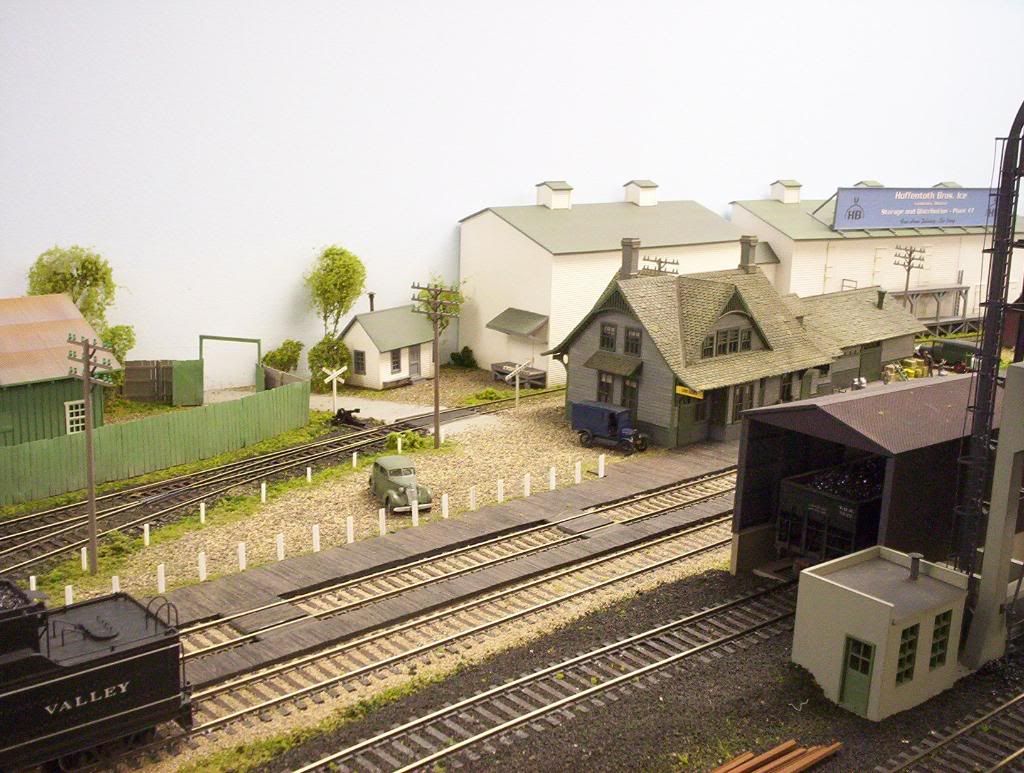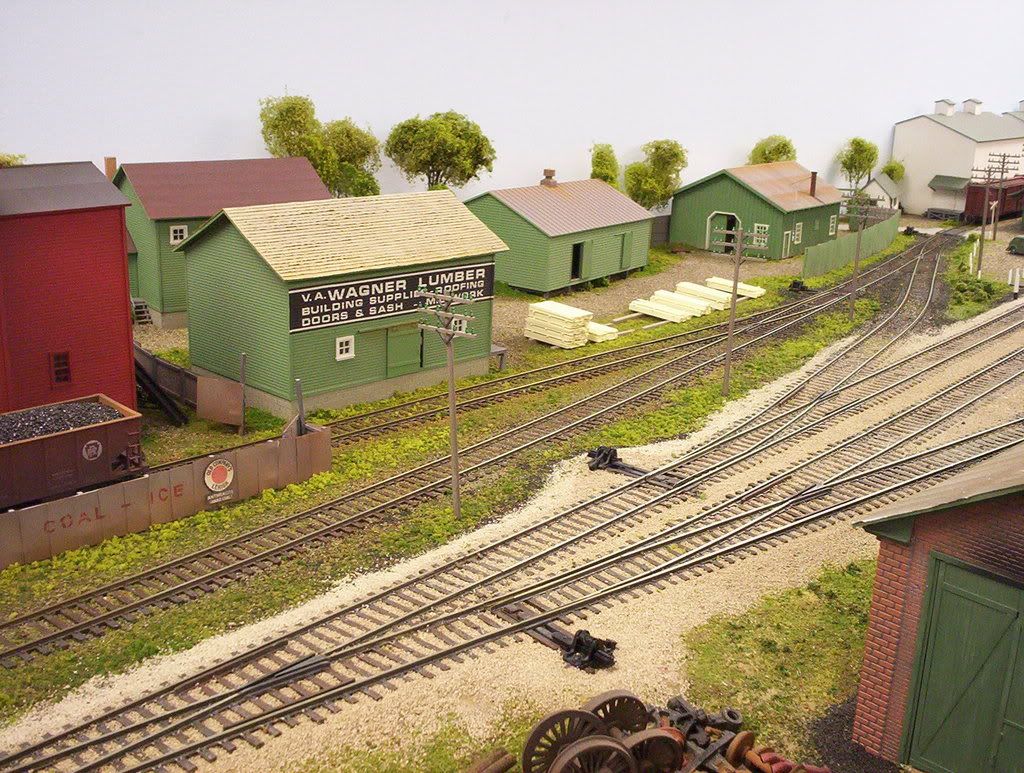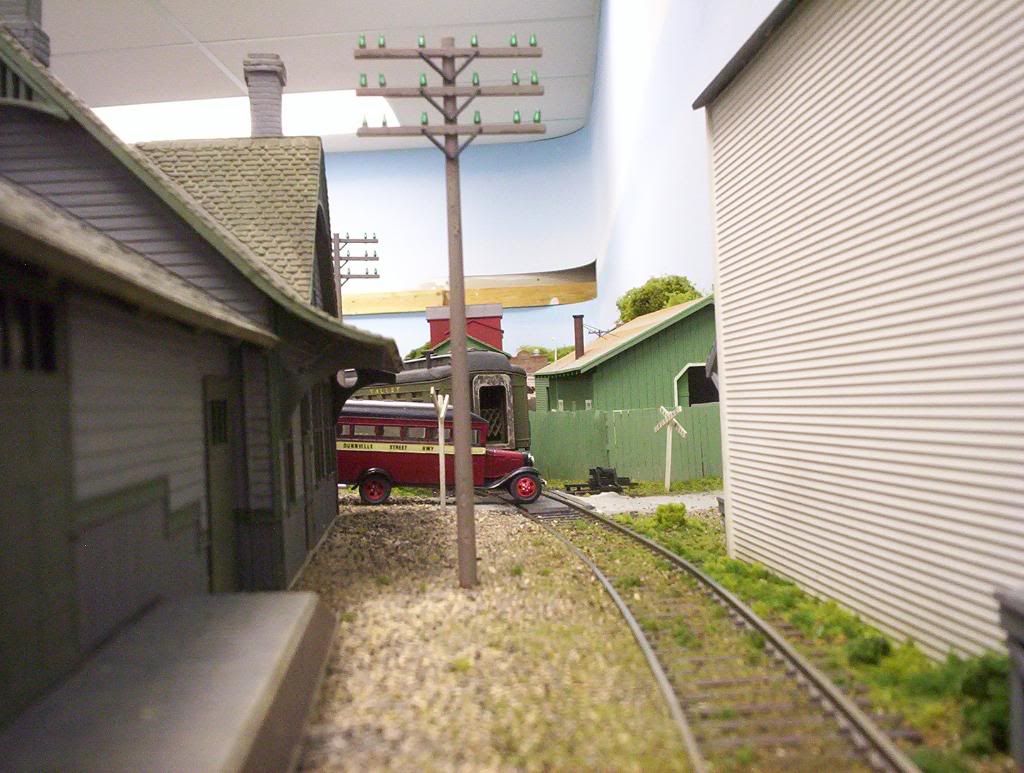I’m looking for nails/spikes that fit code 83 atlas track. Their spikes are too big. I don’t want to glue track to the cork roadbed any ideas???
Bob, The way I see it, you have two options. You can either drill a larger hole for the nail holes in the ties or you can use silicone caulk instead of glue. I have some areas on my layout where I simply cannot nail track down (using code 100 track here) and am going to use silicone caulk. I have had some success with using the caulk, liked the results and so, I’m sticking with that [:)]. have fun; happy railroading!
I have used and like the caulk also. If you are using flex track you can hold it in place on your curves with T-pins, then weight it down overnight while the caulk sets. As long as you don’t use an excessive amount of caulk you can easily take it up by sliding a putty knife under the track. Virtually no damage to the track as long as you use a little care, little damage to cork, minor damage to extruded foam (easily filled with a little caulk).
Good luck,
Caulk is my fastener of choice as well. The trick is to just nip open the very top of the spout with a rail nipper. Well above either of the lines usually marked - the marked lines make a great bead for caulking your sink but it’s way too much for tracklaying. Since the hole is too small to poke a nail in to piece the inner foil, I just use a piece of my #20 solid feeder wire. Lay a nice line down the middle of the track, then spread with a putty knife or other spreading tool. I happen to use clear caulk that comes out white and turns clear as it dries - spread out the bead looks nearly clear already, more like a wet spot ont he roadbed then a lump of anything. That’s all you need, it holds very well. Straight sections I usually pin at the ends and in the middle, maybe more if I’ll be working immediately adjacent to that piece in case I accidently bump it. Curves get a few more pins to hold it in position. I just put the pins in diagonally opposite corners of a single tie, I don’t drill holes in the ties. Within a few hours it’s not going to go anywhere, but I leave the pins in until the next day. It goes very fast.
–Randy
Randy, the caulking gun I use has a poker attached to the bottom of it. It’s loosely riveted to the gun, so it swivels out when you need it. It’s about the size of an 8 ct nail.
To answer your original question, Bob, Atlas makes track nails specifically for their track - as far as I know, they’re the same ones as used for their code 100 track. The nail holes on the code 83 track are mostly closed on the top surface of the ties, so you need to open them from below - I’ve found it’s easiest to simply grasp one of the nails with pliers, then poke the holes from the underside. I usually do a batch of 20 or 30 pieces before starting to lay the track, rather than stopping every time I need another piece.
The advantage to using nails is that you can easily adjust the track after it’s in place and in-use, but before it’s ballasted - you’d be surprised by what minor shifts will occur when you apply power to the track and run trains over it. Many of the adjustments won’t even require removing nails, but rather just pushing the heads sideways slightly. I ran trains for a couple of months before ballasting, working out all the little deviations in the track until trains would consistently run flawlessly. If you wish, you can remove the nails after ballasting, as the hardened ballast will hold the tracks in place. I left mine in place - they’re not really noticeable unless you shoot pictures looking down the track, and even then, I don’t find them objectionable.



Wayne
I’ll have to check it, but somehow I don’t think my $1.99 special has that. It does have a spout cutter though. Probably still too big - the hole I cut is about equal tot he diameter of the #20 wire (with insulation). Anything much bigger means either too much caulk or having to leave blobs rather than a continuous line. So much caulk that it oozes around the ties is defintiely too much, especially if you want to be able to pop the track loose and change it without damage.
–Randy
I don’t want to glue track to the cork roadbed any ideas???
I wouldn’t glue track down either, but I do recommend LATEX Caulk, not silicone. Spread it very sparingly as Randy suggests, and then it is easy to get the track up later if you need to re-work it. I also use a few Atlas track nails.
I use a combination of Liquid Nails and nails. I like Liquid Nails better than caulk because it dries much faster ( just hold it place for a minute or so and track stays). I do use it sparingly though in case I have to move track later. A hobby knife under the track will cut it loose easily. Also Liquid Nails comes in a small tube for hobby projects. Very small and easy to use and not much waste. I try to nail down track as much as possible though since its so easy to remove the nails and it doesnt take many nails to hold nscale track on cork in place especially on straight sections. Ballasting tends to hold track in place too so it seems like the nails just need to hold the track temporarily.
I’ve seen the recommendation for latex rather than silicone caulk once before without explanation. What’s the advantage of latex in this application?
Using Liquid nails because it dries faster then latex caulk is nonsense, The caulk you are supposed to use is DAP 3.0 advanced kitchen & bath Kwik dry. This stuff sets up in 3 minutes. Read the article by Tony Koester in Realistic Reliable Track you definitely need to use the correct caulk
You can use wire nails to hold it in place while doing your preliminary track work etc.that can be had at your local home center instead of buying Atlas track nails I would give you the size but it’s right on the tearof the label when I opened the package so do what I did and walk into Lowes like a geek with a piece of flex track in your hand or a couple of Atlas track nails may be less noticeable…lol
but when you want to put it down for good, you run a bead down the center of the roadbed and spread it thin with a 1" putty knife. center the track down on the roadbed and you can use weights etc. to hold it down but come back in five minutes and it’s there to stay. How ever if you do need to remove it gently slide the putty knife under the track and slowly work it down the length of track you want removed. I just did this no more then an hour a go on a section where I decided to cut in a turnout. All it takes is patients and a steady hand. I don’t use cork I use Homabed so maybe thats the difference but I doubt it.
I’ve seen the recommendation for latex rather than silicone caulk once before without explanation. What’s the advantage of latex in this application?
It’s cheaper and it doesn’t stink.
–Randy
Liquid Nails dries hard - not really a good thing when it comes to mounting track. I hate the stuff, after 2 different failed projects. One involved the foamboard version and pieces of wood, the other involved their bathroom tile version and using for the actual intended purpose - 2 weeks later it was FINALLY dry and I was able to use the toilet paper holder I installed with it. So - Liquid Nails brand gets a big thumbs down for me.
You can use ANY latex adhesive caulk. I use whichever one is cheapest. It’s instantly tacky, and even stuff that doesn’t claim to dry in 3 minutes will hold all but sharp curves after a few minutes. This is why I like to use the ones that dry clear - it comes out white and gets more and more transparent as it sets up. When it’s clear - apart from deliberate action your track is stuck in place. All caulk is adhesive to some extent, otherwise the bead around your bathtub would just fall right out, however the stuff that actually says adhesive caulk seems to have a different perrcentage of volatile compounds in it, based on looking at a tube of each I have. The tube labeled ‘latex adhesive caulk’ is also significantly lighter than the tube labeled ‘all-purpose latex caulk’.
–Randy
I’ve seen the recommendation for latex rather than silicone caulk once before without explanation. What’s the advantage of latex in this application?
I have seen several of the recommendations also, I believe it has to do with being able to get things (paint, other glues, etc) to stick to it after it sets. Several of the references have been about getting paint to stick to it. I assume by the varried references, that other things may not stick to it well either.
Just my memory of a long ago post and my impression from other comments made.
Good luck,
I’m looking for nails/spikes that fit code 83 atlas track. Their spikes are too big. I don’t want to glue track to the cork roadbed any ideas???
I use pins to fasten down my N scale track. If they’ll go through the holes in code 80 N scale ties, they should go through the holes in code 83 HO scale ties. I bought them many years ago at a hobby store so I forget exactly what they are called, but the term “ship builders pins” or something like that seems to stick in my mind. I got enough to last me my lifetime. I’ve got both steel and brass pins. You could use dressmaker’s pins, but they might be too long.
Good call Seamonster.
What you want to look at are model ship planking nails. They come as short as 1/4" (6mm actually) and about .030 diameter (.75 mm). There are also nailing tools available to handle the small nails. I’d check “ModelExpo” or one of the other model ship supply firms on line. Micro Mark might be a thought as well.
A second thought would be “insect mounting pins”. These are extremely fine gage pins and they have to be cut since they’re rather long. The # 000 are very useful for building craftsman wooden kits, even in N scale. (they won’t split the wood) I get mine from an outfit called BioQuip, but lots of places sell them, I prefer the Czech pins in black enamel. They come in various head sizes.
Use of latex caulk works well. I prefer the ones that dry clear. Spread the caulk with an old credit card so it’s barely visible to the eye. For N scale you’ll find that some brands of map push-pins fit almost perfectly between the rails for track placement.
Hope this was helpful.
Thanks everyone. I finally found the perfect nails. 19 gauge 1/2" long for straight and 18 gauge 3/4" long for curves in LOWES. I looked there before but they must have been out of them. These are perfect. and with a nail setter they sit almost flush to the ties - invisible once ballasted, and they allow me to “adjust the rails” or cut in turnouts easily.
Bob if you paint your track before you ballast you’ll never be able to find them